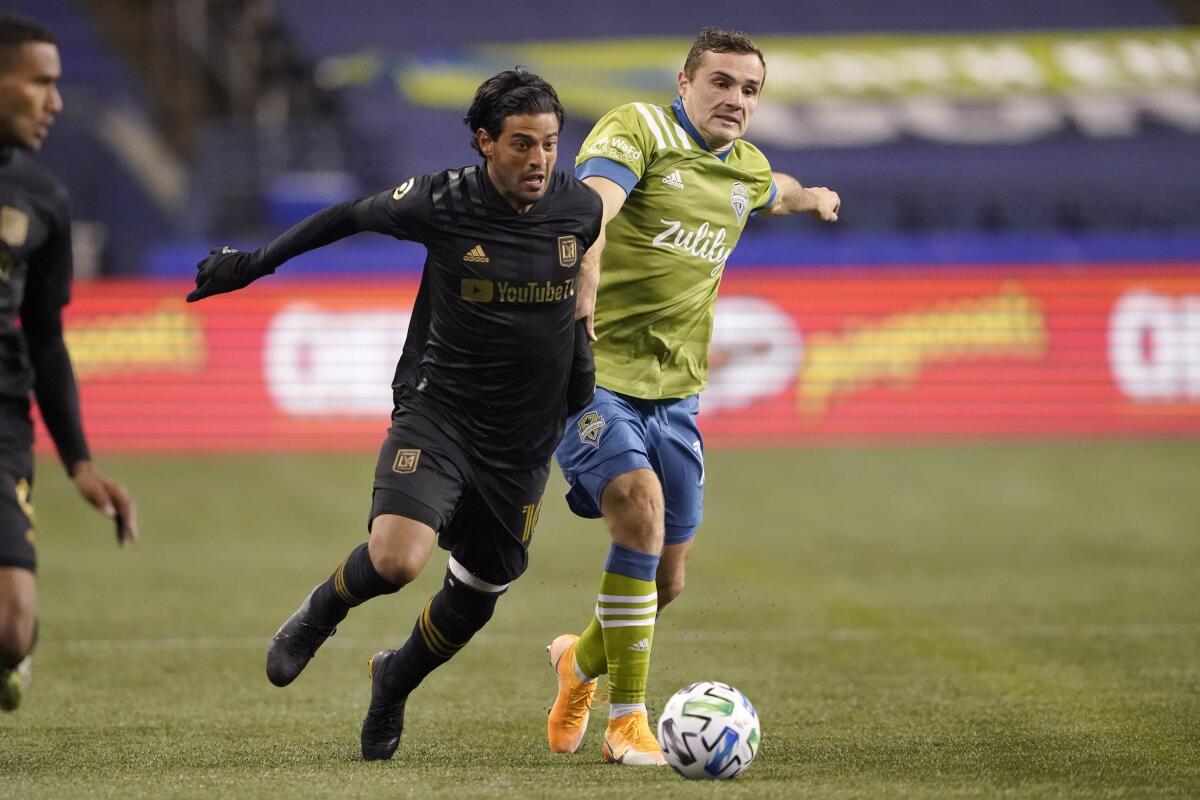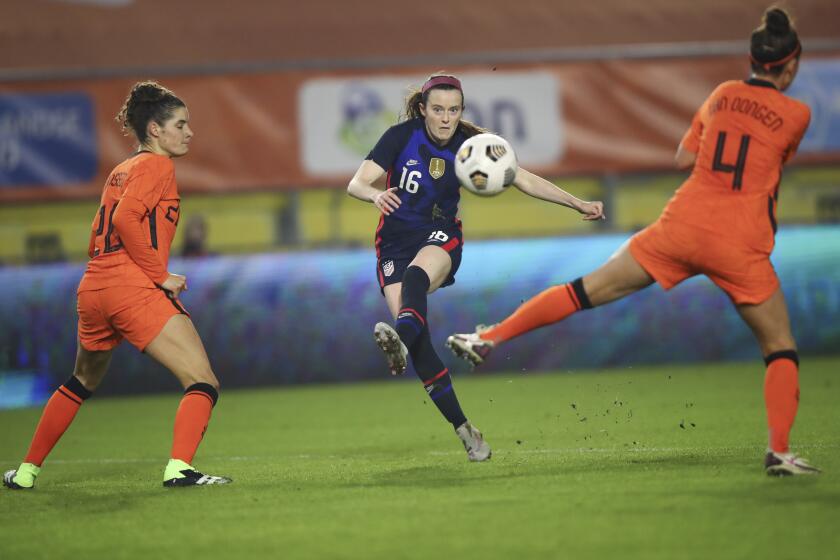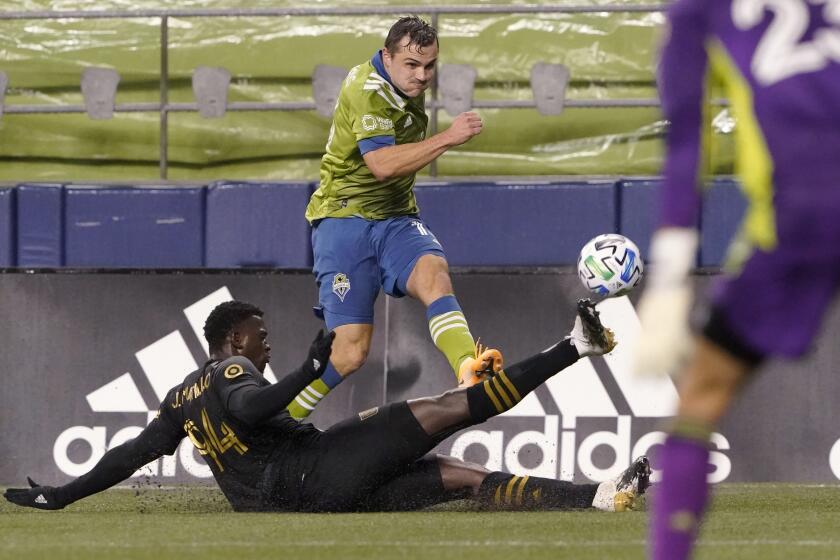Commentary: Poor front-office decisions lead to LAFC’s downfall

- Share via
From the team’s founding in 2014, the people around the Los Angeles Football Club have known nothing but success. Well, regular-season success anyway, tempered by the now-traditional playoff collapse.
LAFC fashioned a passionate supporter culture out of thin air, built the most expensive soccer-specific stadium in the country, then won more games and scored more goals in its first two seasons than any expansion team in Major League Soccer’s modern era, claiming a Supporters’ Shield and breaking the single-season record for points along the way.
All of which made the results of the strange COVID-19-interrupted 2020 season, one that ended in another early playoff exit last week, even stranger. In the final three months LAFC lost more games than it won, saw seven players sidelined by the virus and got as many starts from 16-year-old academy product Christian Torres as it did from reigning MVP Carlos Vela.
Diego Rossi, who played the loyal and quiet sidekick to Vela the first two seasons, stepped up in his absence and scored a league-high 14 goals, the first time in MLS history teammates have led the league in goals in consecutive seasons. Rossi was also named the league’s best young player while free-agent signing Bradley Wright-Phillips, second on the team in goals and assists, was named comeback player of the year.
But that’s pretty much it for the good news.
During the first two seasons, everything general manager John Thorrington and coach Bob Bradley touched turned to gold. This year it all turned to stone, starting last winter when Thorrington made three key decisions that set the tone for the lackluster season.
Ending their longest layoff in more than three decades, the U.S. women’s soccer team beats the Netherlands 2-0 in a replay of the 2019 World Cup final.
First he traded goalkeeper Tyler Miller, who had a league-best 1.00 goals-against average, to Minnesota United for $200,000 in cash considerations and replaced him with Dutch veteran Kenneth Vermeer. Miller, 27, whose confidence had been tested at the end of 2019, rebounded nicely in Minnesota, going unbeaten in five games before suffering a season-ending hip injury. Meanwhile Vermeer, 34, quickly lost his starting job, giving up 16 goals in eight games.
Miller made less than $78,000 in 2019; Vermeer was signed using targeted allocation money, meaning his deal was worth more than $612,500.
Next Thorrington decided not to renew the contract of right back Steven Beitashour, 33, who was due a raise from the nearly $300,000 he made in 2019. Thorrington had a younger option available in Honduran international Andy Najar, so he sent $350,000 to Nashville in exchange for the top spot in the allocation rankings and used that selection on Najar, who made just one start.
But the most damaging move came just a week before the season opener when LAFC traded center back Walker Zimmerman to Nashville for as much as $1.25 million in allocation money, a league record for a defender. It was a deal the budget-conscious Thorrington couldn’t afford to pass up, yet one that proved costly just the same.
Without Beitashour and Zimmerman, the two most dependable defenders from its first two seasons, LAFC used a dozen players on its back line and never did find chemistry there, conceding a franchise-worst 1.7 goals a game. Only two playoff teams allowed more.
In short, the season was a disaster. And one of the team’s own making.
Sure, COVID-19 played a role in all of that, interrupting the schedule twice and twice robbing LAFC of four starters at the same time, preventing the team from gaining any momentum — it won consecutive games just once all season. Bradley said the virus wasn’t an excuse for the team’s struggles, but it was probably a reason.
The rebuilding will begin Monday when LAFC must decide which options it will exercise and whom it will attempt to bring back. Defenders Jordan Harvey, 36, Dejan Jaković, 35, and Mohamed El-Munir, 28, who combined to make 39 appearances, are all out of contract, which could lead to another shakeup on the back line this winter.
And while the core of the team — Vela, Rossi, Tristan Blackmon, Latif Blessing, Eduard Atuesta, Brian Rodríguez and Mark-Anthony Kaye — is locked up for at least another season that doesn’t mean they’ll all be coming back. Rossi, 22, and Rodríguez, 20, are interested in European moves while Blessing has reportedly drawn interest from Brazilian club Vasco da Gama.
As the Zimmerman trade proved last winter, anyone on the LAFC roster can be had if the price is right.
LAFC loses to Seattle in the playoffs for the second consecutive year after Carlos Vela misses a penalty kick and a goal is disallowed upon review.
LAFC still has a chance to salvage something from an otherwise lost year when the CONCACAF Champions League (CCL) resumes next month in Orlando, Fla. But even that is another vivid reminder of just how much the team’s fortunes have changed since the pandemic interrupted the season for the first time on the second Thursday in March.
That night LAFC, riding a three-game unbeaten streak, was to play Mexico’s Cruz Azul in the first game of the two-leg CCL quarterfinals at a sold-out Banc of California Stadium. The game was canceled because of the virus hours before kickoff and LAFC didn’t play again until the MLS Is Back tournament in July, where it ran its unbeaten streak to eight in a row.
When the schedule resumed in home markets and empty stadiums in late summer, however, LAFC went 7-9-2, winning just once in nine tries on the road and bowing out with an uninspired 3-1 loss in Seattle in the playoff opener. It was a fitting coda to a season that saw LAFC lose more than just a lot of games, it lost its mojo as well.
The next few months will tell if Thorrington and Co. can remember where they left it.









